Osteochondrosis is a common disease of the degenerative-dystrophic type, in which the structure and function of the vertebrae and intervertebral discs are impaired, which causes infringement of the roots of the intervertebral nerves and thereby causes symptoms. Osteochondrosis is a chronic pathology that arises under the influence of a complex of reasons - from the evolutionary and anatomical features of the structure of the human skeleton to the influence of external factors, such as working conditions, lifestyle, excess weight, injuries and others. Most often, osteochondrosis of the cervical and lumbar spines is diagnosed as the most exposed to stress. Treatment of cervical osteochondrosis is complex and long-term, mainly aimed at relieving symptoms and preventing complications.
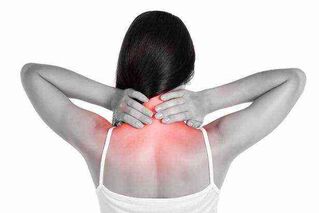
Symptoms
The defeat of the upper spine can manifest itself in a mass of symptoms, depending on the location and severity of the dystrophic process, as well as on how seriously the root structures of the spine of the cervical region are affected. Often, patients' complaints are reduced to symptoms that at first glance are not related to each other, which can complicate the diagnosis and further treatment of the disease.
In general, the clinic for osteochondrosis of the cervical spine is the following series of syndromes:
- Vertebral, characterized by various types of pain in the occiput and neck.
- Spinal, in which symptoms of impaired motor and sensory innervation are observed, in addition, the disturbed trophism of the cervical zone causes gradual atrophy of the muscles of the shoulder girdle and arms.
- Radicular, expressed in pain symptoms in the peritoneal and chest organs, which requires additional careful diagnostics to differentiate osteochondrosis and diseases of internal organs.
- Vertebral artery syndrome in cervical osteochondrosis - vestibular disorders manifested by headaches, hearing impairment, dizziness, up to loss of consciousness.
These phenomena occur when the cause of cerebral ischemia due to infringement of the vertebral artery and weakening of the blood supply.
How to treat cervical osteochondrosis?
Osteochondrosis of the cervical segment develops gradually, and patients usually seek treatment already at the stage of clinical manifestations that interfere with the quality of life, during periods of exacerbation. How to treat osteochondrosis of the cervical spine, decides only the doctor after the appropriate diagnosis, self-medication in this case is unacceptable.
Treatment of osteochondrosis of the neck has the goal of eliminating pain, inflammation, partial or complete restoration of the affected tissue structures and prevention of complications.
Treatment should be mainly outpatient, any procedures at home can only be in conjunction with medical prescriptions, after instrumental and laboratory diagnostics.
In advanced cases, at severe stages of development of neurological lesions and concomitant pathologies, inpatient treatment of cervical osteochondrosis with the possibility of surgical intervention may be indicated.
Medication for cervical osteochondrosis
It consists in the appointment of courses of medicines that relieve the symptoms of pain and inflammation. In the acute period, drugs are shown in injectable form, after some subsiding of pain, the patient takes pills, locally acting agents in the form of ointments, and continues to receive injections.
Non-steroidal anti-inflammatory drugs. They are considered the drugs of choice in the treatment of cervical osteochondrosis to relieve pain and inflammation. These are drugs based on diclofenac and indomethacin, available in different dosage forms. They reduce swelling of soft tissues, thereby reducing pain, local agents have a warming effect, which improves blood flow in the affected cervical region. These drugs are used for 5-10 days, sometimes up to 2 weeks. In the acute period, NSAIDs are prescribed in the form of injections, after a few days the patient switches to the tablet form of administration. It is worth remembering that long-term treatment with NSAIDs negatively affects the mucous membrane of the gastrointestinal tract, for this reason, the course of treatment usually does not exceed 10 days.
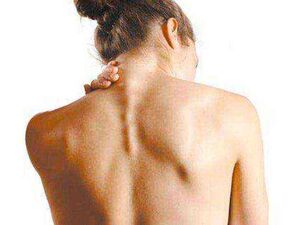
Sedatives such as persen, glycised, tincture of valerian, peony, herbal teas are recommended for prolonged pain and to reduce the risk of neuroticization of the patient, which contributes to the effectiveness of treatment of cervical osteochondrosis. Local irritants. These are locally acting ointments, gels, rubbing that have a warming, irritating and distracting effect. They are not used in the treatment of the acute stage. They contain biologically active substances of plant and animal origin, for example, bee or snake venom. This group includes viprosal, apizartron, menovazin, nayatoks. In the presence of hypersensitivity to the components of the drug and with a high irritating effect, it is better not to use them, so as not to provoke even greater edema. Vitamins. During the period of treatment and further rehabilitation, multivitamin complexes are recommended for use. Usually this is a group of B vitamins, whose representatives are involved in ensuring normal nerve conduction, as well as vitamins A and C, to strengthen the walls of blood vessels and improve blood flow. Taking vitamins reduces vestibular disorders - motion sickness syndrome, dizziness, hearing loss.
Chondroprotectors. These are substances that contribute to the restoration of the cartilage tissue of the vertebral discs of the cervical segment. These include glucosaminoglycans and chondroitin sulfate. Treatment of osteochondrosis of the cervical spine with chondroprotectors is carried out for a long time, 6-12 months.
Orthopedic treatments
Unpleasant symptoms in the cervical spine are often provoked and aggravated by incorrect body position during sleep, a long stay in a forced posture, or trauma. Therefore, the complex of treatment also includes such methods as:

Neck collar, or Shants collar. It is prescribed individually for each patient, after a medical consultation, as it comes in several varieties. The collar is a frame dense roller that fastens around the neck and fixes the vertebrae in the required position. The neck, therefore, does not bend and the head does not turn to the side, which ensures the immobilization of the diseased area, which is important in acute periods. Shants' neck collar can also be made in the form of two rollers with an inflatable layer, into which air is injected with a rubber bulb. Inflation of the interlayer between the rollers stretches the spine, which makes it possible to increase the inter-articular gaps in the cervical spine. The degree of elongation is determined by the doctor, it is not recommended to solve this issue on your own, in order to avoid damage to the neurovascular bundles of the neck. During the recovery period, a fully inflatable collar is used, which retains some mobility of the neck and head.
The collar can be worn at home, no more than 3 hours a day, the general wearing rate is about a month. The final wearing regulations are determined by the doctor, depending on the severity of the condition and the symptoms.
Correct posture. During sleep, it is necessary to maintain the body in an anatomically correct position, when the nerves and vessels of the cervical spine are not compressed, this can be done using orthopedic mattresses and pillows. During wakefulness, the patient needs to control his body position, and correctly choose a desk and chair with an appropriate height. Stretching. The treatment procedure consists in stretching the ligaments of the spine to increase the distance between the vertebrae by 1-3 mm. Traction helps to reduce or eliminate completely the compression of the root disc herniation or bony outgrowths of the vertebra. The procedure removes intervertebral dislocations, reduces muscle contractures. The traction should be carried out under stationary conditions by a physician, and after the procedure, the cervical spine is fixed with a collar or similar devices for several hours. The course of treatment with extractions averages 10-20 sessions.
Massage
Massage for osteochondrosis of the cervical spine is an important and mandatory part of the treatment, together with medication courses. It is prescribed during periods of remission, to accelerate recovery and prevent relapse. Massage is used both classical manual and its varieties from the methods of oriental medicine.
A well-done massage stimulates blood circulation in the neck and collar zone, improves trophism of damaged tissues, relieves muscle and vascular spasm, and gives relief to the patient. The general course of massage treatment is 10-14 procedures, every day or every other day, every 3-6 months. In the presence of severe pain, massage treatment of osteochondrosis is not performed. At home, you can do self-massage of the diseased cervical zone.
Physiotherapy exercises
Exercise therapy is always performed, except for periods of exacerbation with pain. Exercises for cervical osteochondrosis can be performed at home, although it is advisable to do this under the supervision of an instructor until correct execution is achieved. The set of exercises consists of:
Turning the head to the side. Head tilts back and forth. Raising the shoulders with fixed or relaxed hands, holding for 15-20 seconds in this position. Static loads, when the flexor and extensor muscles of the cervical region are strained in turn, the head does not move.
The total number of repetitions is 5-7 times, a session lasts 15-20 minutes. As part of a complex of treatment, exercise therapy helps to accelerate recovery and increase remission.
Physiotherapy and reflexology
In the treatment of osteochondrosis of the cervical spine, electrophoresis with NSAIDs, anesthetics, hormonal preparations is used, diadynamic currents, laser and shock wave therapy are also effective. Physiotherapy at the initial stage of development can lead to a complete cure, and in difficult cases, increase the time of remission. These methods of treatment are used during periods of rehabilitation after treatment of exacerbations.
Reflexology as a method of influencing certain points on the skin of the body, where internal organs are projected, is also used during recovery periods and helps to subside inflammation, improve blood flow, relieve tissue congestion and reduce muscle spasms. Of the methods of treatment, acupuncture, acupressure and hirudotherapy are most often used - placing medicinal leeches on the skin of the cervical region.
The use of these methods can shorten the time and quantity of medication taken, and promote recovery.
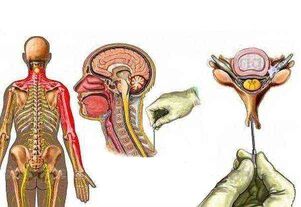
Things to do at home
If the patient's condition allows, the manifestations of cervical osteochondrosis can be treated at home. For example, therapeutic exercises can be performed at home if there are no contraindications and constant supervision of a specialist is not required. It should be remembered that the appearance of pain and crunch in the neck is a reason to stop and seek qualified treatment.
The application of locally acting drugs in the form of ointments, gels, medicinal patches is also carried out at home, strictly according to the medical prescription.
In addition, it is possible to treat at home using some physiotherapy devices - for magnetotherapy and ultraviolet radiation, and devices for reflexology.
Folk remedies are also used in the form of compresses and wraps on the sore cervical region from grated potatoes, horseradish leaves, propolis, aloe and other herbal ingredients. Traditional methods of treating cervical osteochondrosis are palliative, temporarily relieving pain, edema, warming the affected section, and you should not be limited only to them.
All means of treating osteochondrosis of the cervical spine should complement each other and be performed in consultation with the doctor, after a comprehensive diagnosis.
Medical treatment of osteochondrosis of the cervical spine involves the use of conservative methods in order to provide adequate pain relief, and there is no threat of significant disruption to the patient's daily activities.
Symptoms of the disease
Constant bending, lifting, turning and twisting over many years of life, of course, negatively affects the health of the neck and the quality of its structural components. With all these repetitive neck stresses, it's not surprising that roughly two-thirds of people experience neck pain at some point in their lives. Pain sensations can be alarming symptoms of a disease such as osteochondrosis.
Attention! Osteochondrosis of the cervical spine is considered one of the most common pathologies. This disease most often affects people of working age, leading a sedentary lifestyle.
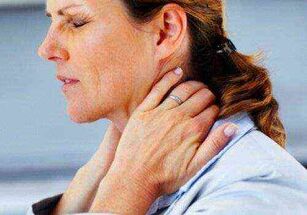
The disease is initially asymptomatic. However, in the case of symptoms such as persistent headaches, as well as pain in the heart and under the scapula, this disease requires immediate and effective treatment.
Degenerative processes can lead to the following manifestations:
- acute pain;
- double vision;
- dizziness;
- numbness in the shoulder area;
- weakness in the shoulders, arms.
This discomfort and loss of mobility can have a significant impact on career, family and quality of life.
The cervical spine is made up of seven bones called vertebrae, which are separated from each other by discs filled with a cushioning jelly-like substance. This design provides the ability to stabilize the neck, smoothly turn it from side to side, and tilt it back and forth.
Over time, these natural shock absorbers wear out and can begin to degrade. The space between the vertebrae is narrowed and the nerve endings are pinched. This process is known as cervical osteochondrosis. Of particular note is that research shows that about 25% of asymptomatic people under the age of 40, and 60% over the age of 40, have some degree of osteochondrosis. As osteochondrosis progresses, the neck becomes less flexible, the feeling of pain in it increases, there is a feeling of stiffness, especially towards the end of the day. It is for these reasons that osteochondrosis develops.
Attention! Its complications can be life-threatening.
Diagnostics and treatment features
Disease diagnosis includes the following general manipulations:
- initial inspection;
- MRI (magnetic resonance imaging);
- X-ray examination.

Drug therapy is the basis for the treatment of cervical osteochondrosis in combination, along with massage. Effective treatments include the following:
- reflexology;
- electrostimulation;
- manual therapy.
Physical therapy can also help reduce pain over a long period of time. The most commonly used methods include:
- acupuncture;
- electrophoresis;
- microcurrent electrical stimulation;
- laser therapy.
Usually, the course of this treatment of cervical osteochondrosis takes about 14 days.
Simultaneously with the application of ice or heat, with the help of a special medicine, it will be possible to achieve pain relief and control pain and inflammation. In addition, exercises for the neck and the shoulder girdle area, performed independently, or with the help of a professional, will also help. Exercise helps maintain flexibility. Exercise, particularly stretching the neck as much as possible, is essential to maintaining flexibility in the neck area. A specific set of exercises should be developed individually by a doctor or physical therapist.
Drugs that can provide relief include nonsteroidal anti-inflammatory drugs and pain relievers.
Attention! You should not use these drugs for more than seven days without consulting your doctor, as kidney failure may be among the serious unwanted side effects they can cause.
Steroid medications and muscle relaxants can also be used.

Treatment during an exacerbation
In the acute phase of the disease, when excruciating pain dominates the clinical picture, the main goal of medical therapy is to relieve pain. In such situations, for a limited period of time, very carefully and competently, and only under the supervision of a doctor can you take analgesics (for example, tramadol, oxadol, ortofen), or more complex drugs (arcoxia). They are able to relieve muscle pain and tension.
Nonsteroidal drugs, which are mostly taken as pain relievers, can also eliminate the cause of pain - inflammatory edema, which constricts blood vessels and nerves.
The use of muscle relaxants allows you to relieve muscle spasm, normalizing the condition of the cervical vertebrae, nerve endings and blood vessels. The use of vitamins is very important.
For severe compression of nerve endings, doctors recommend anticonvulsants. If the pain is not relieved by other means, then it is blocked with novocaine.
If osteochondrosis of the cervical spine is in an acute stage, and is accompanied by severe pain, specialists also prescribe local administration of lidocaine, corticosteroids in order to relieve muscle tension in the spinal motion segment and reduce pain.
In the treatment of acute pain, medications are administered using injections, then it will be possible to proceed to treatment in the form of pills, and further alleviate the health condition using ointments.
Antidepressants are prescribed as a supplement in certain cases. These drugs help to psychologically endure attacks of very severe pain and the specifics of disorders associated with the cervical spine.
Recommendations for treatment in remission
Treatment period in mild stages suggests:
- activation of blood circulation in large vessels and in the periphery;
- improvement of metabolism;
- restoration and renewal of bone tissue and cartilage structures.
For this purpose, the most suitable:
- anti-inflammatory gels and ointments containing steroids and analgesics;
- ointments, the action of which is directed at the point heating of the diseased area, capable of increasing blood flow to the diseased area, and improving tissue nutrition.
Chondroprotectors (chondroxide ointments and tablets) help restore cartilaginous intervertebral discs.
Massage creams and ointments with bee venom, plant extracts have a regenerating, anti-inflammatory, analgesic effect. A therapeutic massage that, if done properly, can be done at home to relieve discomfort. In order not to harm the body, you need to follow a few simple rules:
- do not press too hard on the neck and back;
- all movements should be from top to bottom.
Topical anesthetic creams include capsaicin. Creams are also effective in treating pain associated with osteochondrosis. It is necessary to apply the cream to the area in which the sensation of pain is most present.
Attention! Be sure to wash your hands after rubbing in the cream, especially capsaicin, as the cream can provoke irritation on the skin of the hands or other parts of the body that the hands will touch.
Such an unpleasant symptom as dizziness in osteochondrosis occurs due to vasospasm and inflammation of the nerve tissue. To cope with this help vasodilators and means to improve blood circulation in the vestibular apparatus.
Vitamin B is also included in the complex therapy of cervical osteochondrosis, since it has the following properties:
- restores tissue sensitivity;
- reduces neurological damage.
You need to be very careful about the fact that, although there is a very variable range of quality medicines that help with osteochondrosis, taking many of them is often accompanied by tangible side effects. It happens that the condition of the back improves, but difficulties appear in various organs. It follows from this that medicines are intended only to complement the complex of other methods of combating this disease.
Thanks to an integrated approach to treatment, it will be possible to achieve positive dynamics of the healing process only if the entire spectrum of therapeutic measures is carried out on a consistent, regular and systematic basis.
Often, patients do not pay attention to pain in the neck area, which causes complications.
Treatment with surgery
If the pain persists after six months, during which the competent medication was carried out, and daily activities become more difficult, doctors may recommend resorting to surgery. The operation will be aimed at stopping the movement of the affected cervical spine. It will entail removal of the disc, as well as the insertion of a metal device or bone graft to help maintain or restore normal disc height and neck stability and alignment. Special plates can be used to provide the desired fixation between the two vertebrae.
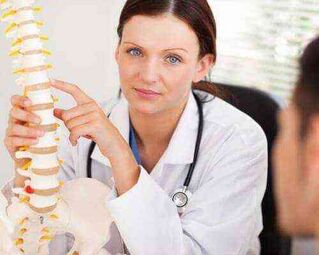
Attention! Patients should be aware that surgery that results in severe neck pain is much less reliable than surgery to relieve pain from osteochondrosis in another part of the body. Thus, if the only or predominant symptom is neck pain, surgery should only be recommended as a last resort, and after all other tried treatment options have failed.
Prevention
Preventive methods of neutralizing relapses are formed by complexes of physiotherapy exercises and therapeutic massage. Correct prevention is an important step towards success.
It will also be very important to pay attention to the fact that you need to adhere to a daily regular diet that minimizes, if not completely eliminated, the intake of salty and spicy foods in order to minimize swelling and improve metabolism. It will also be helpful to do yoga and swimming. Among non-traditional methods, acupuncture and hirudotherapy are often used.


































